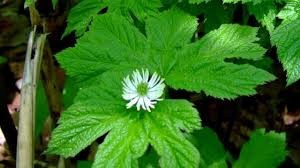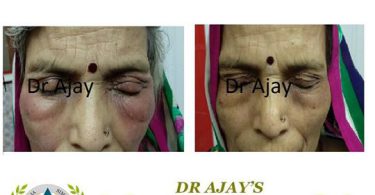Case 1:
Mr. W.H.; white, married, age 28, shipping clerk. Complaints: Epigastric pains, backache, hay fever. About two and a half years ago, with no assignable cause, began having pain in the upper epigastrium when the stomach was empty, near 11 a.m., 4 p.m., and night between mid- night and 2 a.m. Food, soda and magnesia helped, also for the constipation. There had been a good deal of soreness of the stomach. Felt Dizzy or faint-like occasionally, but there have been no red or black bowel movements. Two paternal uncles have had ulcer. His father has gallstones. He does not smoke, and drinks very little. He had similar pains five years ago, some-times with right abdominal tenderness, and a very moderately irritated appendix was removed. He then felt well for about two years. Always had a good deal of watering of eyes and sneezing and has assumed that sunshine caused it. Has had no asthma or hives.
He wanted to gain weight before his present symptoms started, so took lots of milk and with- in two weeks began having his typical pain. He stopped the milk, the pain went away but returned when taking milk again, even in small amount. At another time he stopped using beer and had disappearance of pain. He has now a diet which is free of milk and reduced to minimal roughage.
At times he has bad nasal colds with sore throat at one or two months inrerval, but they usually ceased when the dyspeptic symptoms came to the front. Shortly before his appendectomy he had several abscessed teeth; they were pulled, but he still has two dead teeth. He has no symptoms of heart dysfunction. He had three attacks of pneumonia in early time, all without known complications. Never had any veneral infection.
In May, 1936, he had been treated allopathically for duodenal ulcer, confirmed by X-ray, and had to stay in bed for several weeks. He has been very careful with his diet ever since.
For the last week he complained of severe abdominal pains, in the epigastric region after eating, amel. by warm application, extending in the whole abdomen, waking him around 2 a.m. He prefers warm drinks, a little at a time. Aversion to fats and rich food.
Examination shows a young man of six-foot height and weighing 145 pounds, who therefore looks undernourished. He has a tuberculinic constitution: slender, blond complexion, soft silky skin, long eyelashes, slightly emaciated thorax. The spine shows exaggeration of its curves and some right convex scoliosis. The muscles are not tender; motion is good but he restricts forward bending on medical advice because of recent left sacroiliac disability. The shoulder levels are different. The eyes appear to move normally; pupils are regular and equal, react to light and accommodation. The fundi look normal. The nasal septum has been partially resected a year ago as an attempt to cure his hay fever and deflects towards the left; the passage look boggy and hyperaesthetic. No pus. The tooth shows a good deal of repair, the gums are normal. The tonsils are large and red, the anterior pillars are also red. The post cervical lymph nodes are palpable but small and soft, He hears a watch at about six inches on either side. The thyroid gland is not distinctly palpable. The thorax has good resonance, normal excursion, normal breath sounds and no rales. The heart size seems normal. The first heart sound is abrupt; no murmurs. Radial pulse and artery wall feel normal; B.P. is 102/80. The abdomen shows a left hernio-plasty scar and a McBurney scar, both in good condition. The colon is palpable; lower pole of right kidney likewise. Liver resistance is palpable without tenderness. Spleen and left kidney cannot be felt. There is a definite diffuse tenderness in the epigastrium. Genitalia look normal. Rectal palpation discovers nothing abnormal. Prostate normal in size and consistency. The reflexes are equal on both sides and hyperactive.
Resume of the G.I. series: Chest negative. Oesophagus shows no defects in outline. Stomach smooth in outline. Peristalsis slightly increased in rate. Slight spasm in the prepyloric region, on the lesser curvature. Doudenurn-there a constant irregular deformity of the cap with evidence of a niche. Second and third portions- nothing unusual.
Conclusion:
1. typical duodenal ulcer.
2. Irritable colon.
Blood: Hgb 85% Sahili. Erythrocytes 5,345,000. White cells 6200. C.I, 0, 8; Poly. 50; lymp. 40; Mono. 7; Eos. 3; Bas. O.
Urine: S.G. 1004; pH 4.2; Sugar-neg. Abumin-neg. Micro-normal.
Wassermann: Kahn & Kolmer-negative.
Stool: Occult blood-negative.
Treatment: February 28, 1938: Arsenicum 30 (centesimal), four doses three hours apart.
March 5, 1938: Patient reports an immediate improvement. Has been able to eat and sleep with very little discomfort. Gained three pounds.
March 17, 1938: Some pain the last two nights at 2 a.m. Weight, 150 pounds. Arserricum
10M, one dose.
March 31, 1938: Patient feels fine, except for a slight sore throat and mucous nasal discharge.
Weight, 151 pounds. Placebo.
May 5, 1938: Has been entirely free of abdominal pain. Weight 153 pounds. For the last
few days had a tingling of the nose on waking, paroxysms of sneezing after rising, then a burning lachrymation with a profuse watery bland nasal discharge. Somewhat better in open air and in the evening. Euphrasia 10M, one dose.
May 19, 1938: Patient reports a marked amel. for a few days, but a relapse this last week. It started with a sore throat on the left side, amel. by warm food and drinks. During attack of hay fever, feels stupid, unable to concentrate. Loss of smell and taste. General amel. on lying down. Sabadilla 6x, t.i.d.
June 23, 1938: No change. Hay fever still very active. In previous years he used to suffer acutely until September. There is a definite amel. While eating, also a marked periodicity – Sunday aggravation. Lachesis 10M, three doses, three hours apart, cured the hay fever in twenty-four hours. Patient has been perfectly well ever since. A letter from him, dated June 10, 1939, states that he has had no cold nor hay fever so far this year, no dyspeptic symptoms either.
Case 2
Mr. A.P.; a dark, lean 50-year-old Pole WP.A. worker came to see me at the Homoeopathic Clinic for dyspepsia, from which he had been suffering for over two years. A year ago he was confined to a state hospital for intestinal haemorrhage, and the X-ray disclosed a duodenal ulcer. After three months of rest and diet he was discharged cured. But soon after, in spite of the continuation of his diet, the same pains recurred, growing in intensity for the last two months. He is always worse from 4-11 p. m. and after mid- night, when the pains awaken him with a start. Pressure and constriction of any kind aggravates. He has no appetite. The pains-burning, gnawing in character-start usually two to three hours after meals and extend from the region of the navel towards the liver, the back, and up to the chest and throat, which is burnt by souri regurgitations ending frequently in vomiting. Eating ameliorates for a short while, also unbuttoning his vest and trousers after meals. Stubborn constipation, General chillness. His disposition has become crabby, irascible, and unbearable.
It is impossible to obtain any family history as the patient left home at a tender age and never heard from his people.
Examination shows an emaciated, pale, sick-looking adult of 5’9″ height, weighing 133 pounds. Marked internal strabismus of the right eye. Pupils are iequal and react to light and accommodation. Septal deviation to the right. Artificial upper plate; a few lower teeth left, in poor condition. Cum margin boggy and red. The tongue is dry, twitching and of a dirty gray at the base. Marked halitosis. The chest is lean, emaciated around the’ clavicles. Lungs normal in size; no murmur. B.P. 125/80. Pulse 74, regular.
The abdomen is protuberant, distended, very sensitive to palpation at the epigastric region and round the umbilicus. The liver tender to touch is felt two finger-breadths below the costal margin, The spleen is not palpable. Genitals negative. No adenopathy. The reflexes are exaggerated.
When I put a few discs freshly soaked with Lycopodium 200 he spits them out in a sudden fit of temper and refuses to take any medicine. He had taken too much, he said they made him sick; he thought he would get none at this clinic. After a long argument I succeeded in administering a dose of Lycopodium 200 and prescribed placebo. (November 7, 1937.)
November 16,1937: Grinning sheepishly, if not graciously, the patient comes again to ask for the ‘magic pills’ that took his pains away in less than twenty-four hours. Except for a slight occasional pain the back when standing or bending forward, he has no complaints. Appetite is excellent; the bowels moved spontaneously every day. Disposition is 100% better. Placebo.
November 23, 1937: Gained two pounds; feels fine, took an enema once. Placebo.
November 30, 1937: Gained another two pounds. Feels perfectly well.
I heard of him a year later, he had nothing to complain about.
Note: This case is not only interesting for the
quick response to a high potency in single dose, but also because Lycopodium is usually consid– ered a dangerous remedy to start with in a chronic case.
Case
C.G.; a 38-year-old night janitor, calls at the Homoeopathic Clinic on February 21, 1938, because he is ‘killed by gas pains.’ He had been in a hospital in 1936 for duodenal ulcer, confirmed by X-ray. A medical treatment and a strict diet improved his condition for a while. Lately he has been complaining again of pain in the epigastrium, pressing, burning, or like cramps, extending upward to the chest and shoulders, accompanied by considerable eructations and hiccough. Frequent nausea also when brushing his teeth.
The pains are aggravated three hours after meals; at night wake him up, bending forward; ameliorated sometimes by bending backward, but invariably ameliorated by eating.
Ineffectual urging to stool, although not constipated as a rule. Physical examination reveals a well-developed nervous man of 5’6″, weighing 142 pounds. Except for a whitish coated tongue, there is nothing to mention about the head and thorax. The pulse is slow, regular, at 55; the B.P. 130/80. The abdomen is distended, mostly on the upper part and quite tender on palpation of the epigastric region. The liver is palpable one finger-breadth below the costal margin. Hard masses can be felt along the descending colon, being apparently scybala. Reflexes are hyperactive. The urine shows traces of glucose and indican and many calcium phosphate crystals. I prescribed Anacardium 200, t.i.d. for two days and Placebo. (February 21.)
February 28: Great improvement. Patient has no pain, but still complains of gas. Tongue cleaner. Same weight. Placebo.
March 7: No pain. Tongue has ‘a red tip; the lips are conspicuously red too. Loud eructations. Patient has to urinate two to three times during the night, sticks feet out of bed to cool them. Sulphur 200, one dose.
March 21: Feels “wonderful”. No tenderness on abdominal palpation. No gas. Pulse 65. Urine normal except for marked traces of Indican. Placebo.
I saw the patient’s wife two weeks ago, and she tells me that her husband has been perfectly well.
Conclusion
Here are three patients affected with the same disease duodenal ulcer, cured clinically by three different remedies corresponding to their individual symptoms. No special or rigid diet has been prescribed except for restriction of heavy or concentrated food and acid fruits.
Source: The Homoeopathic Heritage,





